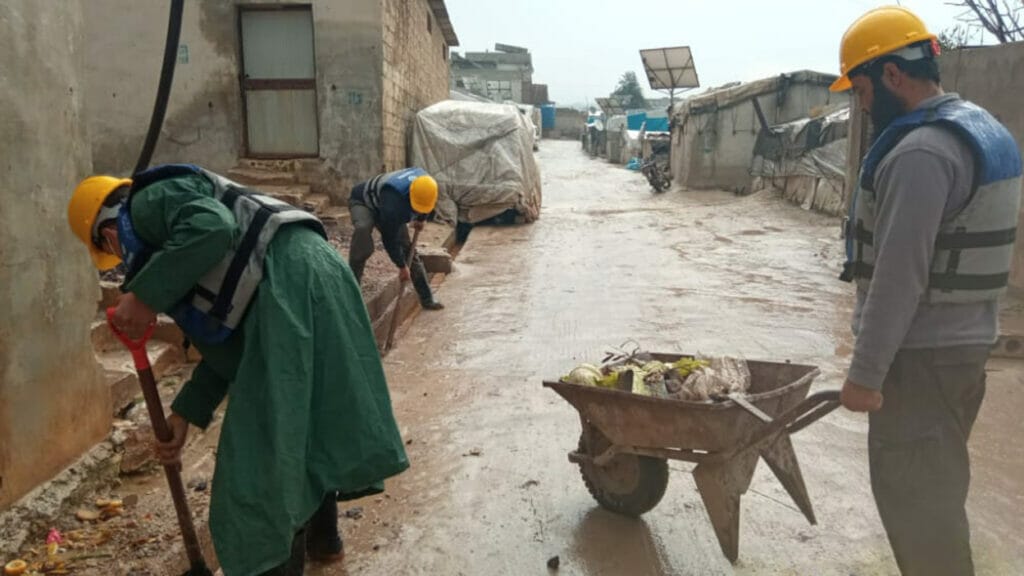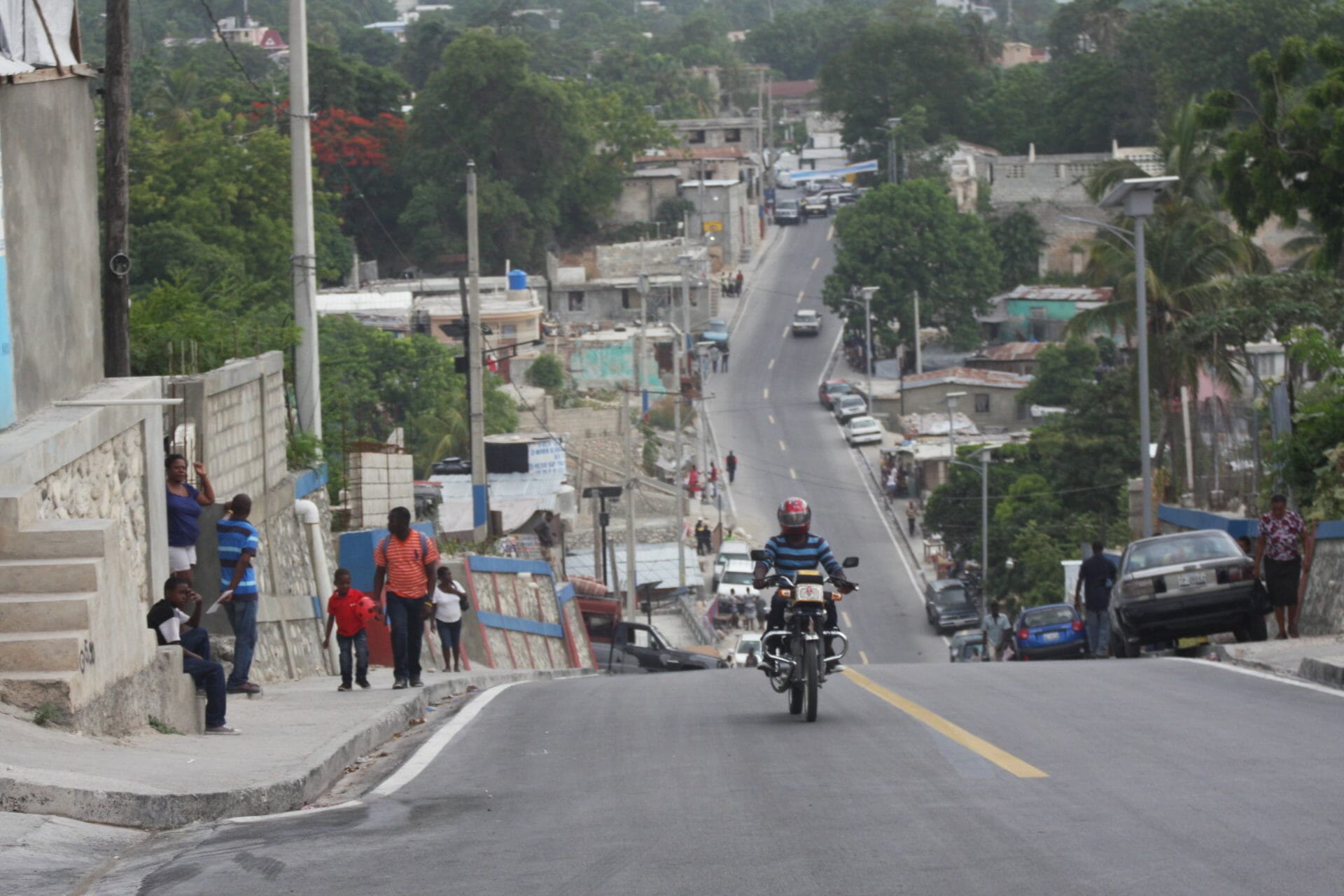As part of our holistic approach to delivering humanitarian assistance, Global Communities aims to identify ways to mitigate against future risks while delivering urgent, lifesaving assistance, and supporting households’ and communities’ ability to recover from natural and man-made disasters.
Our disaster risk reduction interventions mitigate the impacts of shocks on vulnerable populations; prevent the erosion of household assets and livelihoods; and accelerate recovery from humanitarian crises.

Haiti
On January 12, 2010, a devastating earthquake struck Haiti, resulting in the loss of more than 230,000 lives and massive destruction. Global Communities responded immediately. With funding from the U.S. Agency for International Development (USAID), Global Communities launched a major recovery program that focused on large-scale rubble removal and recycling, cash-for-work, construction of transitional shelters and a new type of disaster response using a neighborhood approach.
For example, Global Communities implemented the groundbreaking $8.6 million urban reconstruction program in the neighborhood of Ravine Pintade in Port-au-Prince. In just under 18 months, the integrated approach provided rubble removal and shelter building services, while working with the community on green spaces, plots for schools and proper access roads to cover the basics of sustainable urban improvement.
The program was successful in creating a livable neighborhood with adequate shelter, basic services and other physical improvements. Essential to that success were community mobilization and trust-building efforts, since the support and cooperation of residents were required in order to increase the amount of useful public space. Community mobilization was fundamental in the enumeration process, where local participation fostered consensus on the status of occupancy, tenure and family condition and needs, and in coming up with workable plans for temporary relocation of families while new shelters were built.
Our Approach
In urban areas, our disaster risk reduction work includes utilizing a neighborhood approach to reduce the impact of disasters by improving the conditions of informal settlements, transforming them into safe, healthy and prosperous neighborhoods.
In other urban areas and camp settings, we provide infrastructure upgrades – such as critical improvements in roads and drainage systems – to mitigate the risks of flooding and health concerns caused by stagnant water.
In rural areas, our disaster risk reduction work is tailored to address the unique risks faced by rural communities. In these areas, our activities may include efforts to mitigate the risks of, and respond to, crop fires that would otherwise create devastating agricultural losses for vulnerable farmers.
Our work in this area reaches:
Sorry, we couldn't find any posts. Please try a different search.
Resources
Briefs & Case Studies
‘Survival, Resilience and Solidarity’: Our Relief Efforts in Gaza (Arabic Translation)
Now over four months in, the humanitarian crisis in Gaza has reached catastrophic levels, with one in four households facing famine levels of food insecurity and severely limited access to safe water. “Our mornings begin with a silent check – are the kids, is everyone, alright?” said Mohammad, one of 74 staff members from Global…
Capacity Materials
Community-Led Emergency Action and Response: CLEAR Program
CLEAR is an 18-month, $15 million program implemented by Global Communities and funded by the United States Agency for International Development’s Bureau for Humanitarian Assistance (USAID/BHA). CLEAR is addressing the urgent protection, shelter & settlements (S&S), and water, sanitation and hygiene (WASH) needs for 22,580 people who have been affected by the war in Ukraine.…
Research & Publications
Humanitarian Assistance, Resilience, and Rebuilding: The Long-term Impact of the Neighborhood Approach on Post Earthquake Haiti
Summary of FindingsA Post-Project Sustainability Study of The KATYE Project The January 12, 2010 earthquake in Haiti was the largest natural disaster in the country’s history. Residents were confronted with a tragedy of monumental scale and the daunting task of building back. Among the hundreds of projects implemented in response to the disaster was the…
NEWS
Latest stories from the blog

Charting a Safer Future: How Guatemala’s Communities are Preparing for Natural Disasters
The latest Humanitarian Needs Overview estimates that 75% of the Guatemalan population live in areas at risk of extreme weather events. The Central American country …
Read More
Adapting and Innovating in a Volatile World: Reflections from the 2024 Fragility Forum
By Paula Rudnicka, Sr. Manager for Public Affairs Last month, the World Bank held its 2024 Fragility Forum – a biannual conference that brings together …
Read More
Building a Foundation of Hope: Supporting Guatemalan Households to Combat Shelter Challenges and Food Insecurity
Over the past few years, vulnerable communities in Huehuetenango, Guatemala, have faced the triple shock of COVID-19, prolonged periods of drought and increasingly severe hurricane …
Read More
Disaster Planning Pays Off in Northwest Syria
By Adile Sahin Originally from Hama, Asem has been displaced several times, like most Syrians, to escape the war at home. First forced to flee …
Read More
